Beyond the Cutting-Edge: AI as the New Standard in Healthcare Innovation
===
<div style="display: flex;justify-content: space-between;"><span>by Andy Tran</span><span>April 22, 2024 | Report</span></div>
<br />
<p style="font-size: 1.5em;padding: 1.25em 0;">Exploring the AI-driven technologies and strategies poised to reshape the healthcare landscape.</p>
<hr>
<br />
State-of-the-art AI applications will go far beyond their current capabilities to radically transform healthcare. Imagine a world where AI assistants handle all aspects of medical documentation effortlessly, allowing clinicians to be more present with their patients. Or where AI chatbots bridge the knowledge gap between doctors and patients, empowering patients to take charge of their health journey. These are just glimpses of a future where AI is paving the way towards a more robust, accessible, and patient-centered healthcare system.
> “The AI healthcare market is projected to be worth $187 billion by 2030, with estimates that generative AI (GenAI) will add $150 billion to $260 billion in value to the healthcare industry annually.”
Meanwhile, our current healthcare system is marked by data fragmentation, clinician burnout, and runaway costs, all of which are reaching a breaking point.
The one silver lining is that these challenges have created an opportunity for AI to flourish. Business leaders and innovators can now benefit from the rapidly growing AI healthcare market, projected to be worth $187 billion by 2030 [1]. According to McKinsey, generative AI (GenAI) will add $150 billion to $260 billion in value to the healthcare industry annually [2].
Our report covers the future of AI-driven healthcare. It is divided into two parts:
1) Opportunities in AI across the healthcare landscape
2) State-of-the-art AI technologies pushing the frontier of medicine
# Part I: Opportunities across the AI Healthcare Spectrum
To explore the ever-growing opportunities at the intersection of AI and healthcare, we introduce a conceptual framework called the AI Healthcare Spectrum. This spectrum offers a comprehensive look at AI's potential across the entire healthcare landscape. It does so by grouping the components that make up the healthcare system into six broad domains, ranging from high-level, system-centric areas like public health and research to low-level, patient-centric opportunities in the clinic and at home. Within each domain, we will explore the applications and use cases that show the most promise for AI-led transformation.
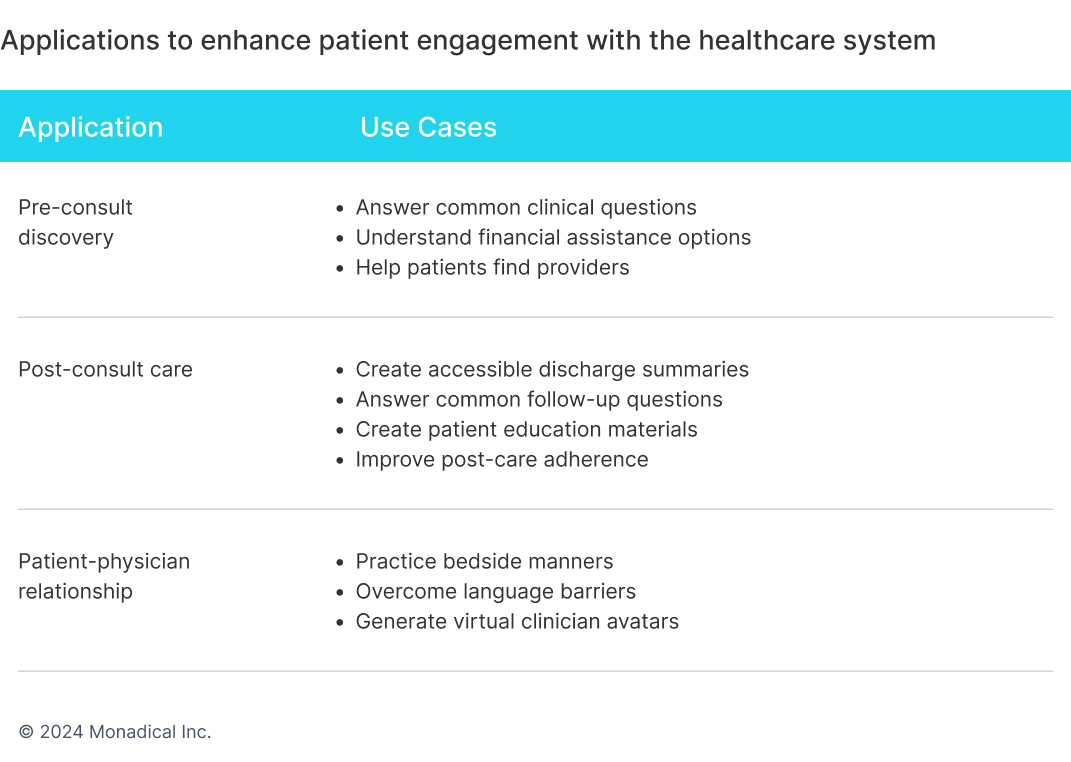
](https://docs.monadical.com/uploads/b5bc9572-3097-4dad-b161-96462ef7b820.png)
## Patient engagement
Patient engagement is the process of empowering patients to be actively involved in their own care. From guiding pre-consultation inquiries to automating post-care communication, AI is well-equipped to tackle the many roadblocks that patients face while traversing the healthcare system. For example, large language models (LLMs) can demystify medical jargon, generate discharge summaries in plain language, automate reminders and follow-up appointments, and answer questions at any time of day [3]. The conversational ability of LLMs also presents unique opportunities for care providers to practice their communication skills and bedside manners, making patient interactions not only more efficient but also more engaging. Empowered patients are able to make better decisions about their care options, thereby improving the safety and quality of healthcare delivery.
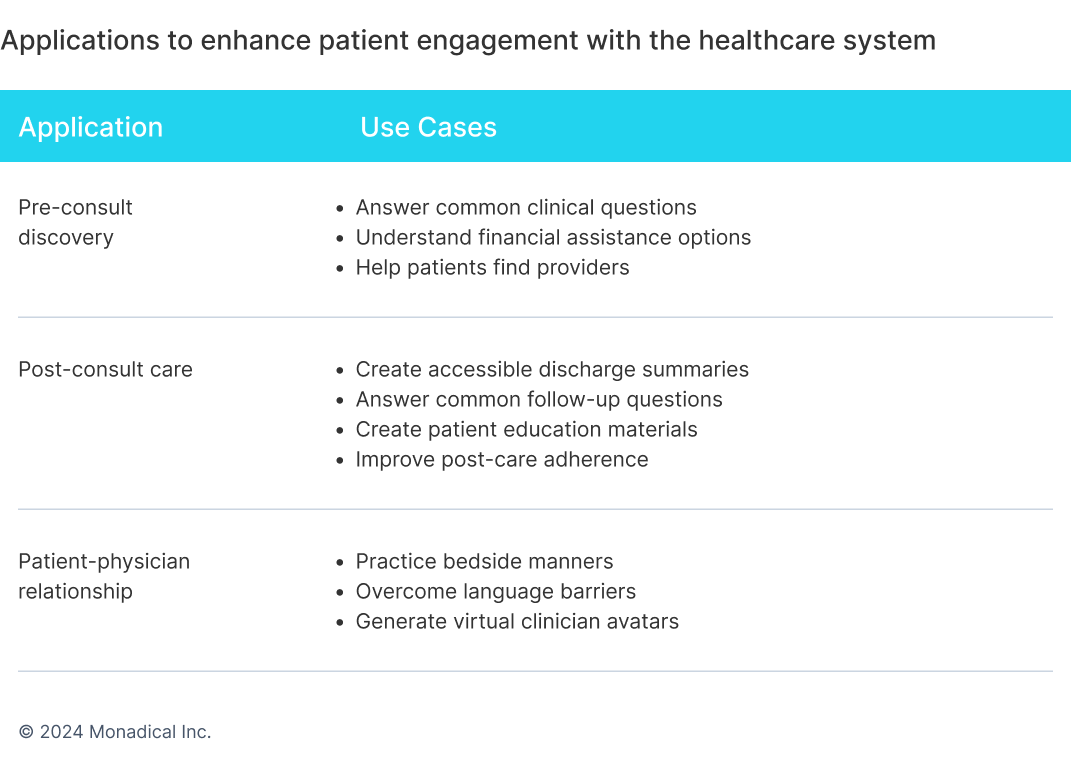
## Clinical support
Clinicians are inundated with busywork in their day-to-day: managing information, creating documentation, responding to queries, and keeping abreast of the latest research and guidelines. AI agents will serve as powerful allies for clinicians by taking on the bulk of the time and cognitive load required for these tasks, allowing providers to focus on what matters most: building relationships and providing exceptional care.
> “AI-powered systems are like tireless virtual assistants, complementing, rather than replacing, the clinician's expertise.”
First, AI can significantly reduce the time clinicians spend on information management. For example, an AI assistant could transcribe conversations, summarize visits, and update electronic health records for every consultation. Instead of being preoccupied with clipboards and monitors, providers can give their undivided attention to their patients.
Furthermore, AI algorithms are purpose-built for analyzing large volumes of unstructured data, such as medical images, gene sequences, and patient records. This ability to distill large quantities of data into concise insights empowers clinicians to make more timely and accurate diagnoses as well as personalized treatment plans. Directing this analytical power towards new scientific literature will also allow clinicians to stay updated on the latest medical research without feeling overwhelmed.
In addition, fewer patients will slip through the cracks when AI is powering remote patient monitoring and real-time data analysis. By collecting health data in real-time and flagging changes in vital signs and providing early alerts, clinicians will be able to provide proactive care to their patients no matter where they are. With this data, AI agents will also support timely interventions or discharges in hospitals, improving health outcomes and patient flow by using scarce resources, like hospital beds, more efficiently.
<div class="case-study">
#### Case study: Optimizing the use of hospital beds with AI-powered insights
Signal 1 develops a digital platform to provide clinicians with real-time patient insights, working closely with hospital staff to integrate their technology into existing clinical workflows. They created CHARTwatch, an AI-based early warning system designed to predict patient risk of clinical deterioration. Deployed at St. Michael's Hospital, Toronto, from 2020 to 2022, the system demonstrated strong model performance by accurately notifying clinicians when patients were at risk of deterioration the majority of the time (AUC 0.76). It also demonstrated adherence to the Good Machine Learning Practices (GMLP), a document providing ten principles to address the deployment of healthcare algorithms jointly endorsed by the governments of Canada, the United Kingdom, and the USA [4]
</div>
Whether by streamlining routine tasks or uncovering insights within complex medical data, AI-powered systems are like tireless virtual assistants, complementing, rather than replacing, the clinician's expertise.
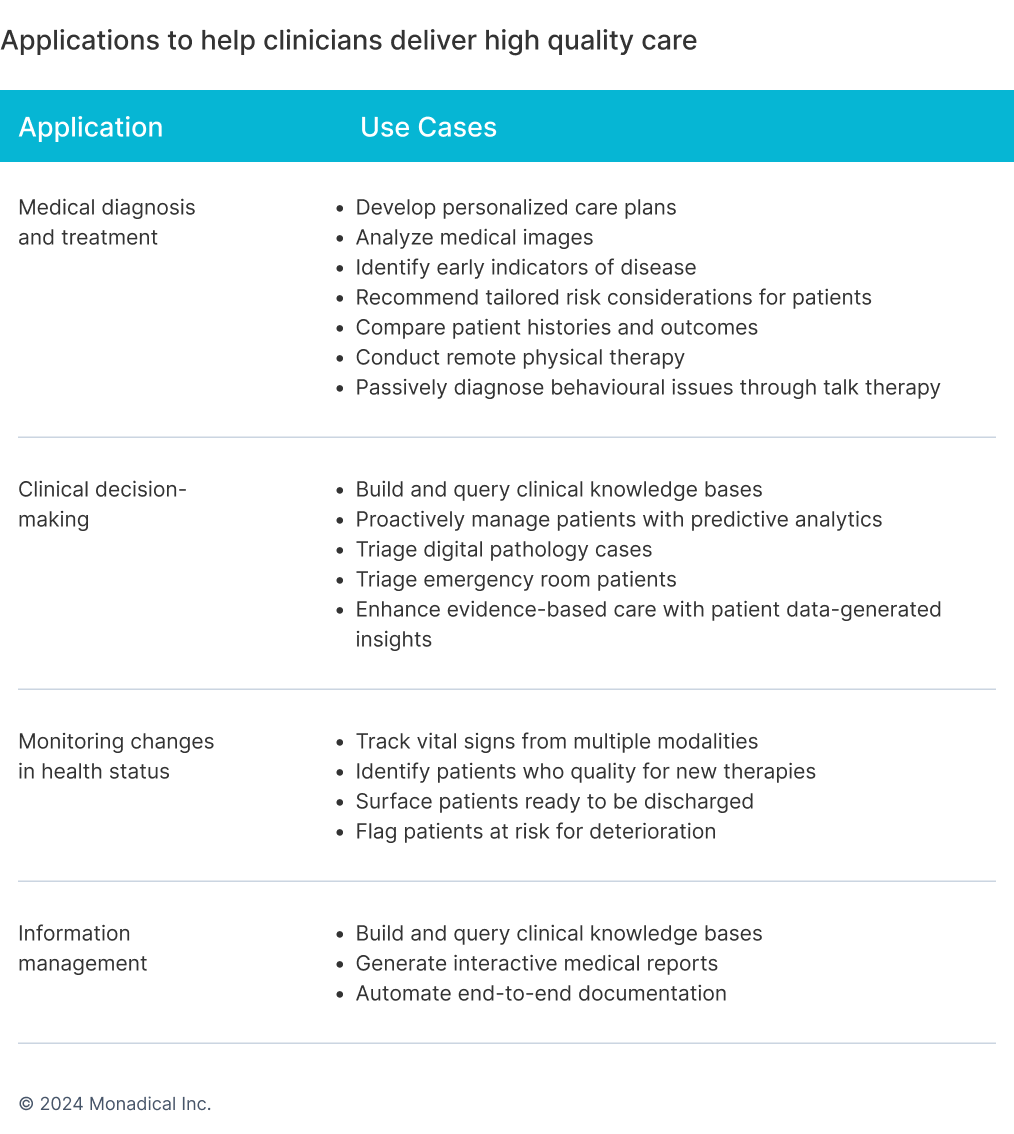
## Healthcare operations
Ensuring that patient care is delivered efficiently and effectively, operational and administrative tasks encompass a wide range of activities, from front-desk operations to back-end administrative work. AI can dramatically reduce the time support staff spend on manual labor by turning data into actionable insights, optimizing workflows, and managing resources more efficiently. For instance, multimodal LLMs can combine and analyze various forms of medical data to accurately identify and assign appropriate codes for insurance billing. Automating these processes not only elevates productivity but also improves the allocation of human and financial resources within healthcare organizations.
The jobs described here, i.e. enterprise-level tasks, are particularly well-suited for disruption by AI. These jobs are often repetitive, data-heavy, and labor-intensive, costing the healthcare system hundreds of billions of dollars per year [3, 5]. At the same time, they pose a lower risk to patient safety than jobs involving patient interactions or medical advice. As a result, enterprise-level tasks present a compelling business opportunity for AI adoption, especially by incumbents wishing to enter the market. They offer significant potential for cost savings and efficiency gains while minimizing risks, making them an easier sell to healthcare decision-makers.
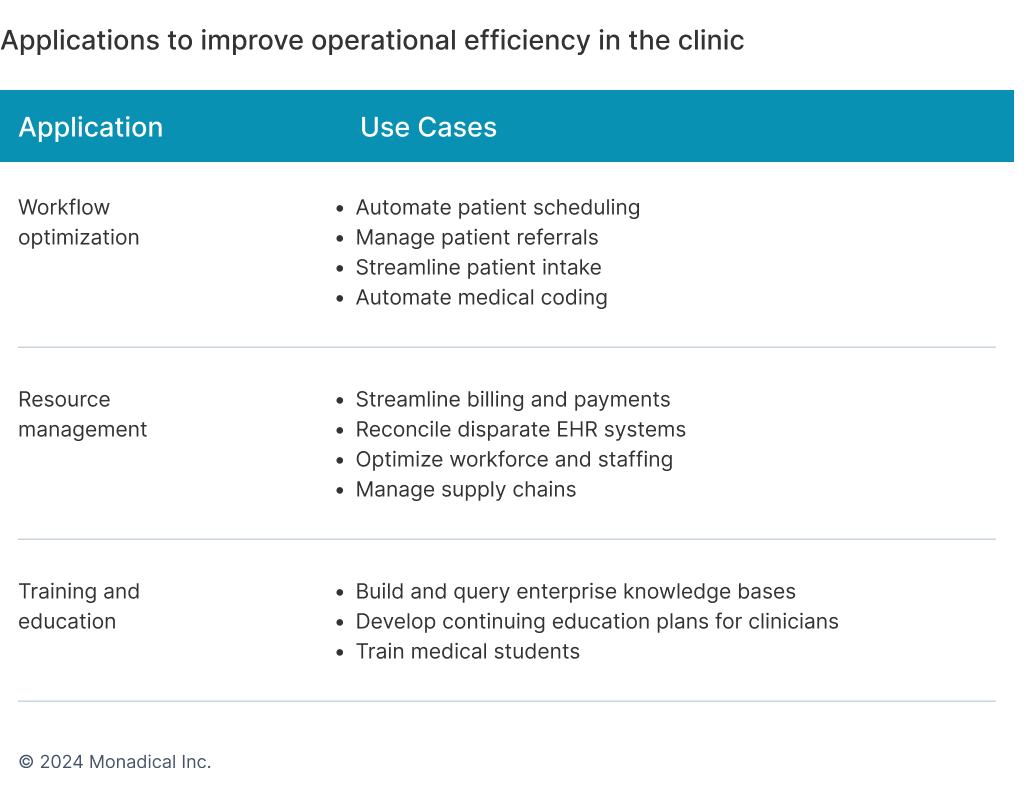
## Financing
At every turn, before or after a medical encounter, patients and providers must grapple with the question: Who will pay for this? How much? And why? The complexity of healthcare billing creates friction for patients and administrative burdens for providers.
Conversational AI agents equipped with robust knowledge retrieval systems offer solutions to these challenges. These agents help patients navigate their benefits, providing clear and up-to-date answers to their questions about coverage and costs. By automating the tedious processes of claim submissions, denials, and prior authorizations, these systems can also streamline operations for providers and payers, cutting down the time spent on back-and-forth negotiations and enhancing user satisfaction across the board.
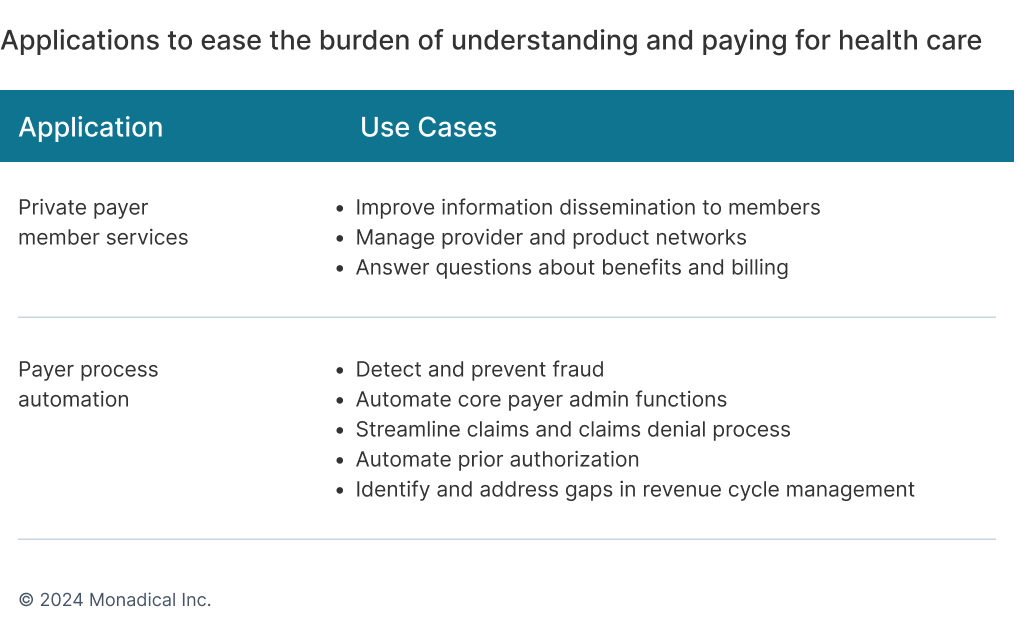
## Research & innovation
Medical research has long been propelled by machine learning and data science, and now, generative AI is poised to push the field even further.
Besides distilling scientific literature and enhancing research documentation, LLMs are well-equipped to manage clinical trial planning. For example, by leveraging their advanced natural language processing capabilities, LLMs can effectively analyze and reconcile the various terminologies and ontologies found in electronic health records and clinical trial inclusion/exclusion criteria. This enables them to conduct patient-trial matching while respecting patient privacy, streamlining the matching process to produce more efficient medical research [6].
GenAI’s role also extends to unraveling complex biological mechanisms, such as protein folding and gene sequencing. A landmark study from MIT researchers showcased their diffusion model’s capacity to imagine new protein structures. This technology opens up a wide range of opportunities in biomedicine, including the development of more potent antibodies and the design of nanoparticles for targeted gene delivery [7]. By harnessing the power of big data, GenAI will not only accelerate the pace of innovation but also ensure that research outcomes align more closely with patient needs and safety standards.
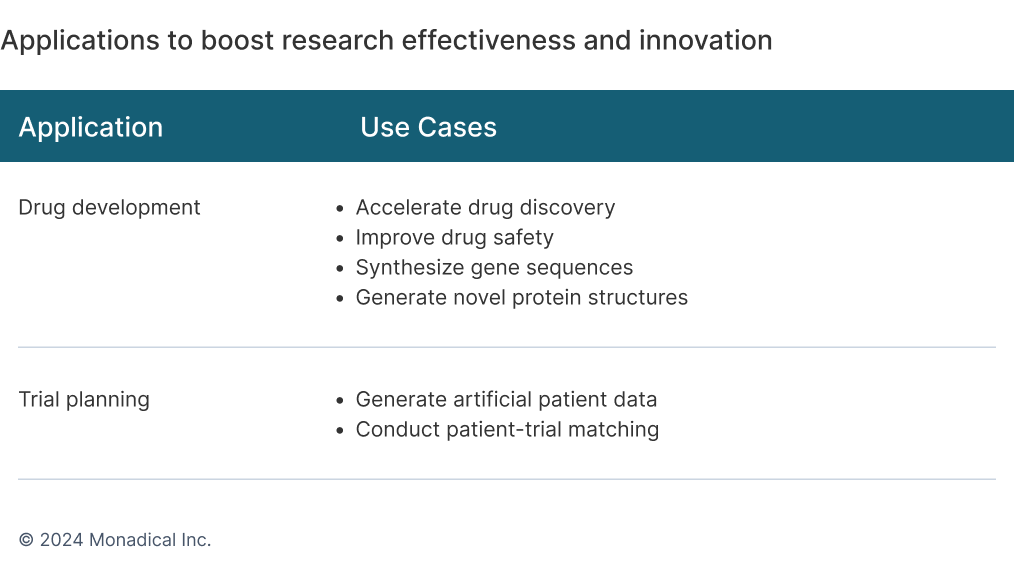
## Public health
In the realm of public health, AI's role is rapidly expanding, offering improved capabilities for disease surveillance and understanding the needs of different communities. For example, screening stations in high-traffic areas equipped with computer vision technology can flag individuals who exhibit flu-like symptoms, curtailing the spread of infectious diseases and possibly preventing another pandemic from happening. On the other hand, LLMs could analyze patient records for social determinants of health - non-medical factors that influence health outcomes - that are easily missed during consultations. Recognizing and addressing these determinants can reduce health inequities among a population.
By drawing on vast data sets and predictive modeling, AI provides public health officials with novel tools for proactive, evidence-based policy-making and community health interventions. Effective public health policy can reduce the burden on healthcare systems, control the spread of disease, and ensure healthcare is delivered equitably and fairly to everyone, regardless of their background.
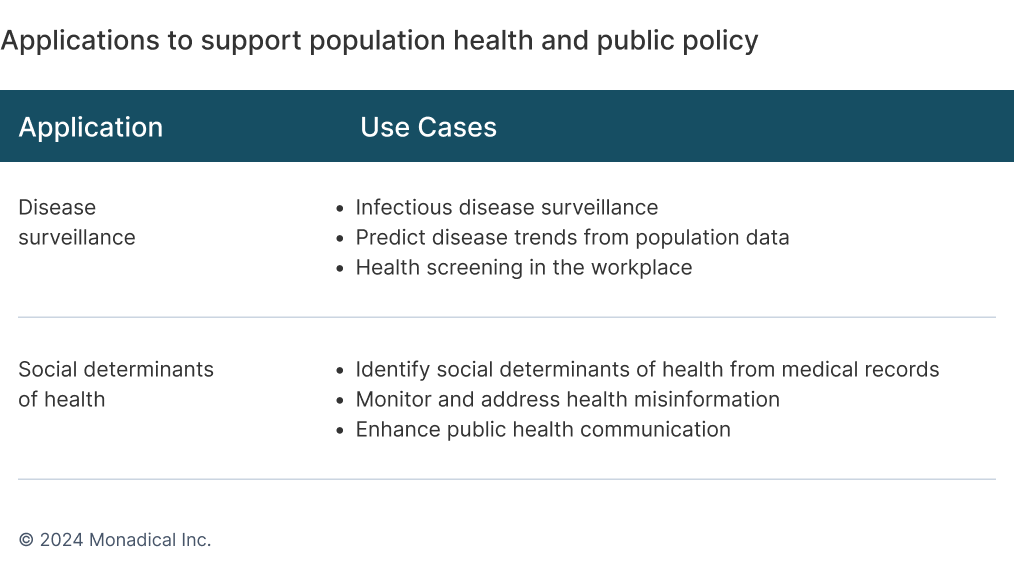
# Part II: State-of-the-art technologies pushing the frontier of medicine
Innovators in AI have thrived by standing on the shoulders of giants. Each technological breakthrough inspires waves of researchers and creators to develop new specialized models, frameworks, and tooling, which not only unlocks greater possibilities in healthcare but also tests the limits of what can be achieved.
> “The biggest winners in this space will find a way to combine the best of both predictive and generative AI.”
While the frontier of AI research has been dominated by GenAI, predictive AI (also called “traditional machine learning”) remains a cornerstone technology in healthcare. In contrast to GenAI, which focuses on creating content, predictive AI attempts to forecast the future, playing a critical role in areas like disease detection and cancer screening. The biggest winners in this space will find a way to combine the best of both predictive and generative AI. For instance, imagine a platform that can anticipate patient needs, predict disease progression, and then design uniquely tailored therapies for them.
In this section, we explore state-of-the-art AI technologies poised to transform healthcare. Our selection reflects current trends in research publications and venture capital investment, highlighting areas of rapid innovation. This list is non-exhaustive, as the rate of new developments in the field continues to grow at breakneck speed.
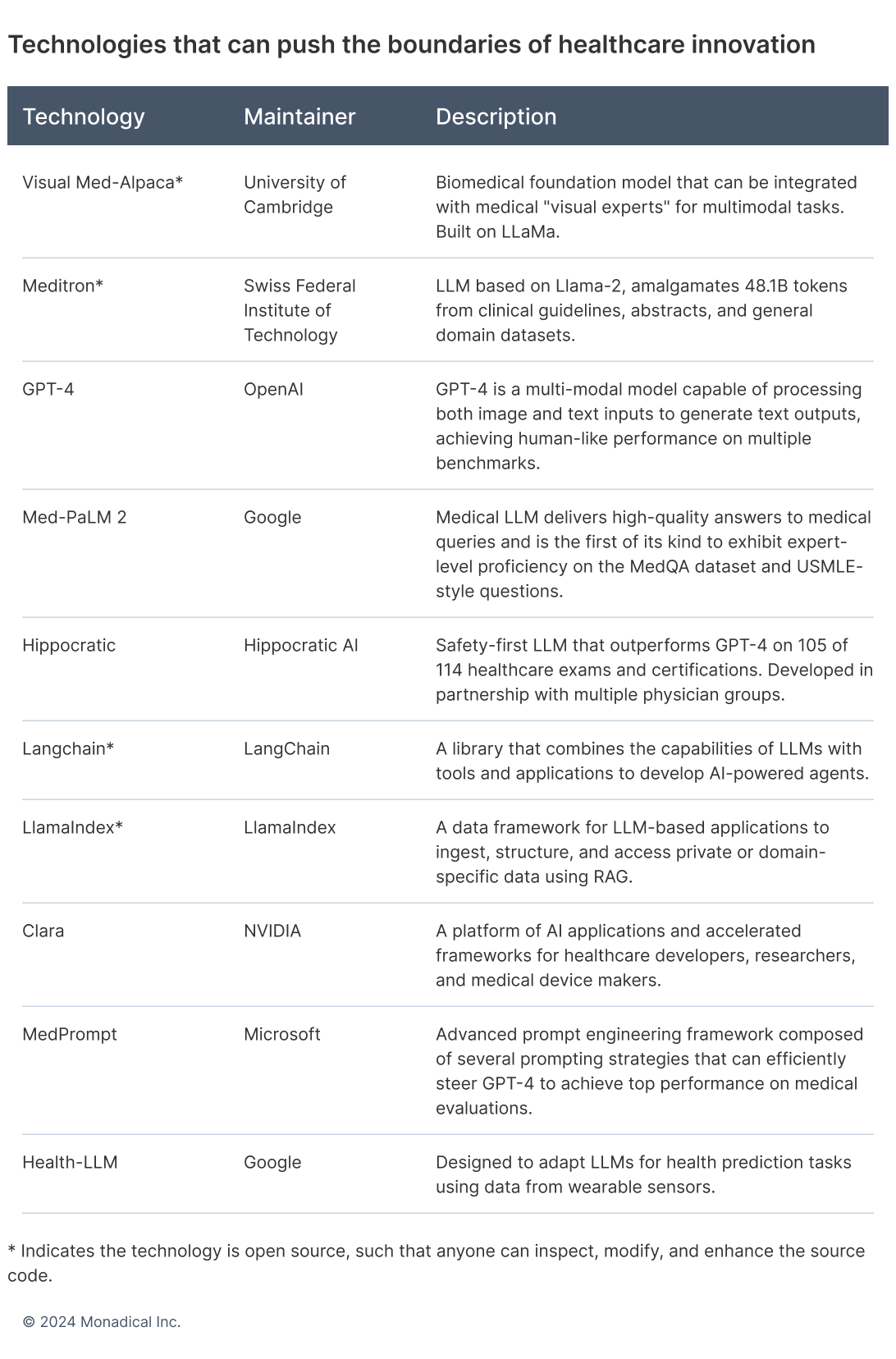
## Knowledge augmentation will be a key step in the AI stack
Knowledge augmentation will be a crucial step in the AI stack. For example, techniques like retrieval-augmented generation (RAG) address a significant limitation of LLMs because of these models' reliance on static or “old” data. While RAG is the dominant architectural approach, other techniques like few-shot learning, model composition, and prompt engineering are also widely used. RAG can incorporate the latest medical research or clinical guidelines into a model’s context window or “thought process,” generating more informed and accurate responses. This ensures that healthcare decisions are informed by the latest evidence, enhancing patient outcomes.
## Multimodal LLMs are the next generation of innovation
The proliferation of multimodal LLMs (MLLMs) marks a significant shift in AI research and development. Galvanized by the unveiling of Google’s Gemini in 2023, these powerful models are trained on a range of modalities, including images, gene sequences, audio waveforms, and other types of unlabeled data. MLLMs have been shown to be more robust and accurate than unimodal models in tasks like patient assessment, risk prediction, and pathology diagnosis [10].
Beyond using MLLMs to perform inferences and predictions, they also have the potential to produce rich, multimodal outputs. Imagine an interactive radiology report that displays images alongside captions and highlights the region described by each phrase [8, 11]. We are only scratching the surface of possibilities as researchers continue to build different frameworks for integrating multiple modalities into existing LLM architectures.
## AI agents can tackle healthcare’s hardest problems
LLMs and other computational models excel in basic queries and conversations but need help with complex deductive reasoning, such as answering patients' questions. AI agents, on the other hand, are well-suited for these tasks.
An AI agent is an autonomous software program designed to interact with its environment, gather information, and use that data to make decisions and take actions to accomplish predefined goals. To do this, an AI agent may use various tools and resources, such as web browsers, calculators, and other external APIs. At the core of the agent sits an LLM or other machine learning algorithm, which can reason through a problem and create a plan of action with the support of its tools.
> “AI agents promise to address healthcare’s hardest problems. Companies that understand how to build and leverage sophisticated agent systems will gain significant tailwinds in this space.”
For example, imagine a triage agent that is capable of handling patient intake, assessing constraints and priorities, and then referring patients to the right department, or a learning agent that assists medical students in becoming better surgeons. In fact, that is one of the use cases researchers explored with ChatGPT, where it was shown to be adept at scientific writing, doctor-patient communication, diagnostic imaging, and managing patients’ perioperative care. [12]
Although AI agents have not yet been widely used in healthcare, they show great promise for addressing some of healthcare’s toughest challenges. Companies that understand how to build and leverage sophisticated agent systems will gain significant tailwinds in this space.
## Predictive AI remains a cornerstone of mission-critical medical applications
Predictive AI continues to anchor mission-critical medical applications in fields like oncology and pathology. These applications have traditionally relied on machine learning algorithms like decision trees and K-means clustering to make classifications (e.g. benign versus malignant tumors) or produce probabilities of having a disease. While generative AI is not typically used for such tasks, recent research has shown that LLMs fine-tuned on specialized medical datasets are able to achieve human-like accuracy in diagnosing psychiatric disorders, including depression, anxiety, and PTSD [13]. This presents a compelling opportunity for LLM-powered talk therapy tools to play a vital role in mental health screening and support.
## Prompt engineering
Developing custom AI models is expensive and out-of-reach for most small companies. In these situations, foundation models are invaluable for developing early prototypes or proof-of-concepts, especially when used in tandem with prompt engineering. While GPT-4 can write the United States Medical Licensing Examination (USMLE) with expert proficiency out of the box [8], advanced prompt engineering techniques, e.g. few-shot learning and chain-of-thought, can boost its performance to the extent that it outperforms fine-tuned medical models like Google’s Med-PaLM 2 [9]. Such impressive feats demonstrated by these foundational models present great promise for newcomers and early innovators wishing to hit the ground running.
## Addressing ethics and safety
Although foundation models hold immense promise for healthcare, they suffer from the real world's biases and prejudices. One study demonstrated that GPT-3 would mirror biases found in its training data, including tendencies toward stereotype consistency, negative information, and social or threat-related content [14]. If disease metrics or patient demographics are not representative of the communities they serve, AI insights may be skewed, further perpetuating population health disparities. Furthermore, integrating LLMs into clinical workflows raises severe concerns around HIPAA compliance, data privacy, and who holds liability when things go wrong. These challenges demand careful attention to ensure AI aligns with the core ethical principles of healthcare.
Fortunately, these issues have fuelled innovation in the open-source community and underscored the need for collaboration between technology experts and healthcare professionals. By training models on patient-centered clinical data, specialized medical models are being developed with enhanced accuracy, safety, and inclusivity. Their focus on delivering actionable, evidence-based insights improves healthcare decision-making while prioritizing patient safety, trust, and the integrity of medical advice.
<div class="case-study">
#### Case study: A safety-first LLM will become the go-to model for healthcare innovators
General Catalyst and Andreessen Horowitz (a16z) led a $50 million seed round for Hippocratic AI in 2023, a company of visionaries building a state-of-the-art, safety-first medical LLM [15]. Not only does their LLM score better than commercial models (like GPT-4) on over 100 medical certifications - ranging from pharmacy and psychiatry to bedside manners and policy - Hippocratic AI is remarkable for being a truly interdisciplinary team composed of physicians, hospital administrators, policy experts, and AI researchers. Their rigorous attention to safety, compliance and privacy earned them one of the largest seed cheques a16z has ever written.
</div>
The imperative to balance innovation with equity, privacy, and patient welfare presents a compelling challenge - one that invites all stakeholders to collaborate in a shared future where AI is a beacon of excellence and ethics in healthcare.
# Conclusion
The untapped potential of AI within healthcare represents a multi-billion-dollar opportunity with tangible payoffs in quality, efficiency, and patient outcomes. From patient engagement and clinical support to research and public health, AI is poised to reshape every facet of the healthcare landscape. Healthcare leaders should prioritize early adoption of proven AI applications, focusing initially on automating time-consuming administrative tasks and augmenting clinical decision-making with large language models.
However, realizing the full potential of AI in healthcare requires more than just technological advancement. It demands a collaborative effort from all stakeholders – innovators, healthcare professionals, policymakers, and patients themselves. We must work together to address the ethical challenges, ensure equitable access, and prioritize patient safety and privacy.
The journey towards AI-powered healthcare is not without its challenges, but the rewards are immeasurable. By harnessing the power of AI, we have the opportunity to create a healthcare system that is more efficient, effective, and compassionate. A system that empowers patients, supports clinicians and drives innovation will deliver better outcomes for all.
---
This report was made possible by the support of Monadical, a leading edge software consultancy. If you are a founder or company working on new ways to utilize AI in healthcare, please reach out to hello@monadical.com.
---
Special thanks to Elliot Goldman, Hanna Jodrey, Jordan Steiner, and Gokul Mohanarangan for their contributions to this report.
# Glossary
State-of-the-art (SOTA): The most advanced and highest performing technology or method currently available in a particular field.
Generative AI (GenAI): A subset of artificial intelligence that focuses on creating new content, such as text, images, or music, based on learned patterns from existing data.
Foundational model: A large, pre-trained AI model that can be adapted and fine-tuned for various downstream tasks, serving as a foundation for more specialized applications.
Large language model (LLM): An AI model trained on vast amounts of text data, capable of understanding and generating human-like language for tasks such as translation, summarization, and question-answering.
Computer vision: A field of artificial intelligence that focuses on enabling computers to interpret and understand visual information from the world, such as images and videos.
Agent: An autonomous AI system that can perceive its environment, make decisions, and take actions to achieve specific goals or solve complex problems.
# References
1. Stewart C. AI in healthcare market size worldwide 2030. Statista. Published September 28, 2023. Accessed February 12, 2024. https://www.statista.com/statistics/1334826/ai-in-healthcare-market-size-worldwide
2. Chui M, Hazan E, Roberts R, et al. The economic potential of generative AI: The next productivity frontier. McKinsey & Company. Published June 14, 2023. Accessed February 12, 2024. https://www.mckinsey.com/capabilities/mckinsey-digital/our-insights/the-economic-potential-of-generative-ai-the-next-productivity-frontier
3. Chen J. Bringing Generative AI to Healthcare. Sequoia Capital. Published September 14, 2023. Accessed February 12, 2024. https://www.sequoiacap.com/article/generative-ai-for-healthcare-perspective/
4. Pou-Prom C, Murray J, Kuzulugil S, Mamdani M, Verma AA. From compute to care: Lessons learned from deploying an early warning system into clinical practice. Front Digit Health. 2022;4:932123. Published 2022 Sep 5. doi:10.3389/fdgth.2022.932123
5. Rughani J, Wolf D, Pande V, Yoo J. Commercializing AI in healthcare: The jobs to be done. Andreessen Horowitz. Published September 18, 2023. Accessed February 12, 2024. https://a16z.com/commercializing-ai-in-healthcare-the-jobs-to-be-done
6. Yuan J, Tang R, Jiang X, Hu X. LLM for patient-trial matching: Privacy-aware data augmentation towards better performance and generalizability. Published March 30, 2023. Accessed February 12, 2024. https://arxiv.org/abs/2303.16756
7. Gordon R. Generative AI imagines new protein structures. MIT News. Published July 12, 2023. Accessed February 12, 2024. https://news.mit.edu/2023/generative-ai-imagines-new-protein-structures-0712
8. He K, Mao R, Lin Q, Ruan Y, Lan X, Feng M, Cambria E. A survey of large language models for healthcare: from data, technology, and applications to accountability and ethics. Published October 5, 2023. doi:10.48550/arXiv.2310.05694
9. Nori H, Lee YT, Zhang S, Carignan D, Edgar R, Fusi N, et al. Can generalist foundation models outcompete special-purpose tuning? Case study in medicine. Published November 2023. doi:10.48550/arXiv.2311.16452
10. Kline A, Wang H, Li Y, Dennis S, Hutch M, Xu Z, Wang F, Cheng F, Luo Y. Multimodal machine learning in precision health. Published April 10. 2022. doi: 10.48550/arXiv.2204.04777
11. Moon JH, Lee H, Shin W, Kim YH, Choi E. Multi-modal understanding and generation for medical images and text via vision-language pre-Training. IEEE J Biomed Health Inform. 2022;26(12):6070-6080. doi: 10.1109/JBHI.2022.3207502
12. Cheng K, Sun Z, He Y, Gu S, Wu H. The potential impact of ChatGPT/GPT-4 on surgery: will it topple the profession of surgeons? Int J Surg. 2023;109:1545-1547. doi:10.1097/JS9.0000000000000388
13. Galatzer-Levy IR, McDuff DJ, Natarajan V, Karthikesalingam A, Malgaroli M. The capability of large language models to measure psychiatric functioning. Published August 3, 2023. doi:10.48550/arXiv.2308.01834
14. Acerbi A, Stubbersfield JM. Large language models show human-like content biases in transmission chain experiments. Proc Natl Acad Sci U S A. 2023;120(44). doi:10.1073/pnas.2313790120
15. Hu K. Hippocratic AI raises $50 million seed funding to build models for healthcare. Reuters. Published May 16, 2023. Accessed February 12, 2024. https://www.reuters.com/business/healthcare-pharmaceuticals/hippocratic-health-raises-50-mln-seed-funding-build-ai-model-2023-05-16/
Beyond the Cutting-Edge: AI as the New Standard in Healthcare Innovation
Recent posts:
- Vibe code isn't meant to be reviewed *
- The Scraping-With-Cookies Dilemma
- Conversations are the New Oil
- Don't Give Big Tech Your Papaya
- View more posts...
Back to top
